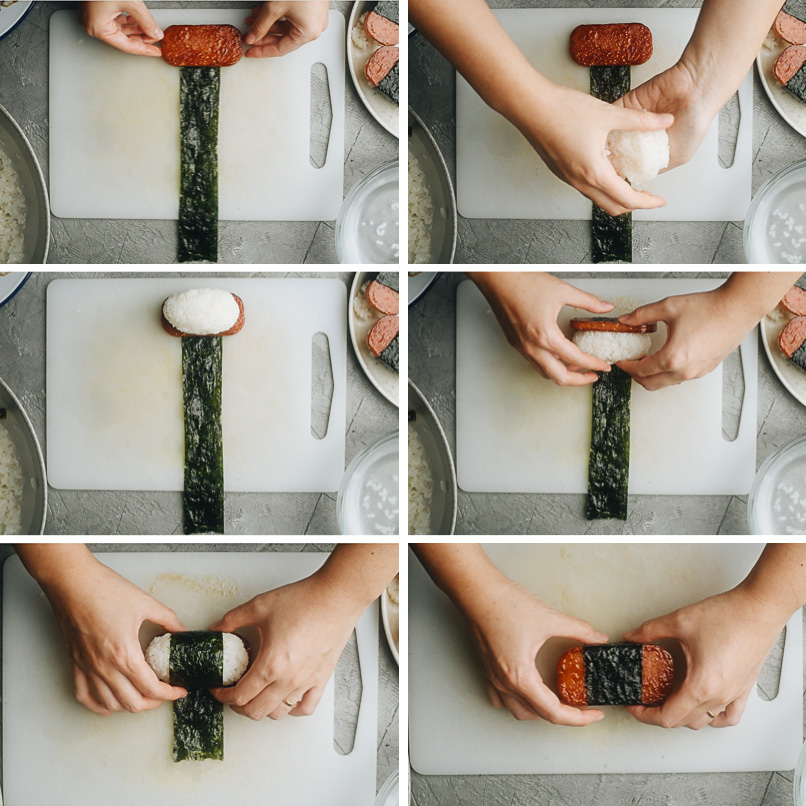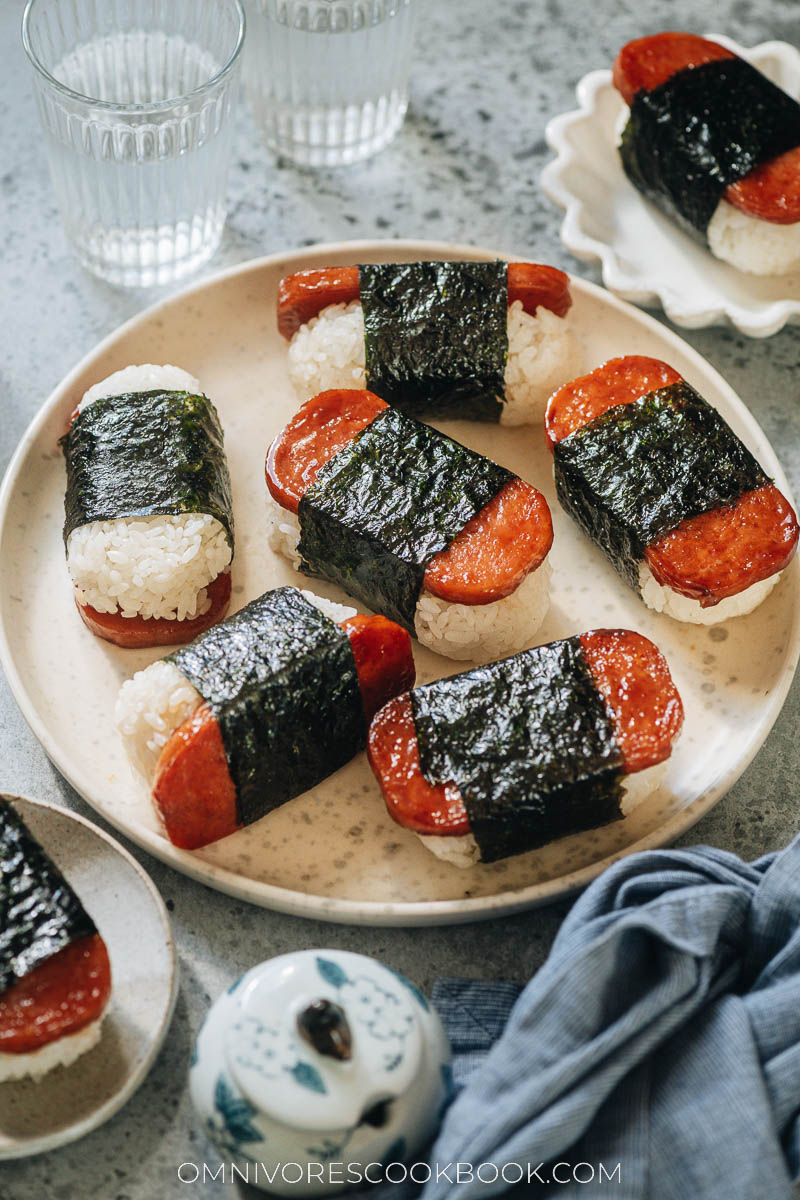
Spam & Chinese cooking
The word Spam might make you think of high-sodium military rations. But in China, Spam is a popular ingredient that people use in comfort food. Spam and pepper stir fry, Spam omelet, Spam ramen, Spam fried rice, or Spam sandwich. You name it.
Spam is also a common ingredient in Chinese Hot Pot and Sichuan Mala Dry Pot – a popular type of Chinese restaurant where you choose a spicy sauce and various ingredients that are cooked in it and then everything is served in a big pot. Every time I go to Mala Pot restaurants with friends, I remember to order a few slices of Spam and it’s always the most popular ingredient in the pot.
Spam is so intertwined with Chinese food culture that I’d never considered Spam a foreign food until I moved the US. Then I started to wonder when it came to China.
After some digging, I found out the following. According to Wikipedia:
“In China, Hormel decided to adopt a different strategy to market Spam, promoting it as a foreign, premium food product and changing the Spam formula to be meatier in order to accommodate local Chinese tastes.”
Apparently, Hormel also decided to name it “luncheon meat” (午餐肉) instead of Spam, to make it sound glamorous. No wonder. Back in old days, Spam was considered a fancy thing that people would serve for dinner on Chinese New Year.

A Common Table Cookbook
This spam musubi recipe is slightly adapted from one in the cookbook A Common Table – 80 Recipes and Stories from My Shared Culture, written by my friend Cynthia Chen McTernan, who is the author behind the award-winning blog Two Red Bowls.
I decided to share her Spam Musubi recipe – a great representation of how Asian food inspired local cuisine and became a part of its culture. Even though I got to know this Hawaiian dish only after moving to the US, it makes me feel nostalgic because of the use of Spam, an ingredient that reminds me of time spent with family and friends.

Spam musubi Ingredients
You only need a few very simple ingredients to make spam musubi:
- Cooked rice
- Spam (I prefer the low sodium type)
- Strips of crispy seaweed (nori)
- Soy sauce and sugar for seasoning
Experiment with sushi rice
The original Hawaiian spam musubi does not use sushi rice, which has added rice vinegar and sugar. But when I make my own spam musubi, I always use sushi rice. The refreshing acidic note cuts the greasiness of the Spam, mellows its saltiness, and works perfectly with the sweet taste.
If you’re feeling adventurous, use the sushi rice recipe from Just One Cookbook. The extra 5 minutes is definitely worth it. Her recipe includes a rice cooker version. Check out this post if you need a detailed instruction on how to make rice on the stovetop.
Seaweed (nori)
Make sure you get the large nori sheet that is about 8” (20 cm) to 9” (22 cm) long. It is usually labeled as sushi nori, yaki nori (roasted seaweed), or laver for Gimbap (if you visit a Korean store). They usually come in large, thin, square packages. And you will need to cut them into strips for this recipe.
How to make spam musubi
Cook the Spam
- Brown the spam until crispy
- Braise the spam with sugar and soy sauce, until the surface is caramelized
It’s very important that you brown the spam slowly and thoroughly. It renders some fat and makes a very crispy crust. Then you will use some sugar and soy sauce mixed with water to quickly braise the Spam. You will end up with a beautifully caramelized dark brown surface that is still chewy and sticky. It’s perfect.

Wrapping the spam musubi
- Place a strip of nori sheet on your working surface, then place the spam at the very end
- Make a ball of rice by pressing it together, then shape it into an oval shape that is similar to the sliced spam
- Roll up the spam and rice using the nori strip
- Make sure to tuck the rice tight enough so the musubi doesn’t fall apart, but not too tight that you tear the nori sheet
- Smear the end of the nori sheet with a bit of water and roll up the musubi, so the nori will stay put.

Tips on shaping the rice
You can use a musubi mold to make the rice pressing process much easier and less messy. I only included the traditional way in the recipe, where you use your hands to press the rice. If you like to DIY, you can even use a Spam can to make your own musubi mold (you need to remove the bottom of the can and cut the can a bit shorter).
To make sure the rice doesn’t stick to your hands too much, make sure to always wet your hands before rolling each musubi.
When you press the rice by hand, it’s important to use proper strength so that the rice is pressed together but not overly mashed. If you don’t press enough, the musubi might fall apart when you bite into it. If you press too hard, the rice texture will be too dense. It takes a bit of practice but once you make a few musubi, you’ll get the idea.
How to store and reheat spam musubi
Spam musubi will taste the best when it’s freshly made and you can appreciate the crunchy spam, tender rice, and crispy seaweed. If you serve it within a couple of hours, it’s OK to store them in a container at room temperature. For longer storage, you need to store them in the fridge. If you store them in the fridge, you should always reheat the musubi in a microwave to warm up the rice, to avoid a tough texture.
I’ve not tried freezing spam musubi, but I think it’s totally OK. You should thaw the frozen musubi in the fridge completely, and reheat them before eating.

More delicious recipes for your next party
- Air Fryer Chinese Chicken Wings
- Curry Egg Salad Wonton Cups
- Pork Lettuce Wrap (San Choy Bow)
- Old-Beijing Fried Carrot Fritters (炸素丸子)
- Chinese Fried Stuffed Eggplant (炸茄盒, Zha Qie He)
This spam musubi recipe is slightly adapted from the cookbook A Common Table – 80 Recipes and Stories from My Shared Culture, written by my friend Cynthia Chen McTernan
Chinese Cooking Made Easy
Are you new to this website? This free email series is a great place to start. I’ll walk you through a few of my most popular recipes and show you how and why they work. You’ll quickly start to cook better Chinese food in your own kitchen.
Watch video

Barter-Worthy Spam Musubi
Ingredients
- 1 teaspoon vegetable oil
- 1 can low-sodium Spam (12 oz. / 340 g can) , sliced into 8 pieces
- 1/4 cup water
- 2 teaspoons soy sauce
- 2 tablespoons sugar
- 4 cups cooked sushi rice (or regular cooked short grain white rice) (*Footnote)
- 3 sheets roasted seaweed (nori) , cut into 8 strips about 2” (5 cm) wide and 9” (23 cm) long
Instructions
- Start making steamed rice (or sushi rice) if you don’t have any already made.
- Heat the oil in a 12-inch (30cm) nonstick or well-seasoned cast-iron skillet over medium heat. Add the Spam slices and cook until browned and crispy on the bottom side, 2 to 3 minutes. Flip and cook until the other side is also browned and crispy, 2 to 3 minutes.
- Whisk together the water and soy sauce in a small bowl. Sprinkle the sugar evenly over the Spam slices, then add the soy sauce mixture. Swirl to evenly distribute, then let the Spam simmer until the liquid is nearly absorbed, 3 to 4 minutes. Flip once in between, so the sugar will melt completely and camalize well. Transfer the Spam slices to a plate to cool.
- To make the sushi: Place one slice of Spam perpendicular to the nori strip on the bottom of the strip (forming a cross shape). Wet the palms and fingers of both of your hands, measure 1/2 cup of rice, and transfer the rice to your palm. Use both hands to firmly press the rice into a ball. Then hold the rice ball with your left hand, with your thumb and the other four fingers to secure both sides, use your right hand to gently press the rice ball into a rectangular shape about the size of the Spam slice. Place the rice on top of the Spam. Roll up the Spam and rice so that the nori sheet wraps around it. Seal the end with a bit of water and place the musubi seam-side-down while you work on the rest. Repeat with the remaining nori strips, Spam slices, and rice. Remember to rinse your hands every time, to minimize rice sticking to your hands.
- Enjoy the spam musubi immediately at room temperature. You can store them in an airtight container or wrap them with plastic wrap and place them in the fridge. To serve refrigerated musubi, warm them in the microwave for 20 seconds or so, to get the best texture.
Notes
- A couple of notes on the rice:
When making sushi rice, always use short grain rice. Medium and long grain rice are less starchy and don’t hold together well when pressed into sushi or musubi.
The original recipe uses regular steamed rice, and so do most Hawaiian Spam musubi recipes.
However, I personally prefer making sushi rice, which contains rice vinegar and sugar. The acid and mild sweetness of the sushi rice complement the salty Spam and create more depth of flavor.
You will use about 3 1/2 cup to 4 cups of cooked rice for this recipe. I found my personal favorite ratio is: slice the Spam into 8 slices, and use 1/2 cup of cooked rice per musubi. In my case, I used 4 cups of cooked sushi rice, which were yielded from 2 rice-cooker cups (180ml per cup) of raw short grain rice.
Nutrition

Did you make this recipe?
I’d love to hear how it turned out for you! Please take a moment to leave a 5-star rating ⭐️ and share your thoughts in the comments further down the page. It really helps others discover the recipe too.

Izzy
My favorite Chinese dishes are always the every day home cooked meals; garlic scapes with shredded pork, stir fry celery and lily bulbs, beef and potato stew. Love them all!! Spam musubi is also amazing, I love coating spam in a beaten egg and frying it!
Vivian
Chinese and Vietnamese are my favorite foods followed by Japanese! The foods of these cultures are such clean tasting food and, since my sister-in-law is Vietnamese, I’ve been fortunate to have learned a lot from her. I eat dumplings almost every day for lunch and also enjoy making Chinese Spring Rolls that I keep stocked in the freezer. We recently got a new, really large Asian market and I’m thrilled about the fact I can now have access to more ingredients.
Julie Yen
I love your Lion’s Head Meatballs!
Adrienne
Oh how I remember the days I thought luncheon meat was a pretty gourmet ingredient haha so good with rice! My favorite Chinese recipes are those that reminds me of the home cooked food I enjoyed as a child. Hard to pick a favorite but during the Lunar New Year, I particularly enjoy “luo han zai”. Love that red fermented bean curd sauce.
Stephanie Novinc
So I found your web site looking for Szechwan Eggplant and I’m amazed by the Chinese Eggplant in garlic sauce and the Sichuan eggplant. I use your site all the time when I go to the Chinese groceries by my house. I would love your cookbook we recently moved and I have no more cookbooks. Your book would be a welcome addition to my home.
Sharon Shumway
I love all food Asian. If I had to pick only one type of food for the rest of my life it would be Asian. Some of my favorites are curry chicken, egg foo yung, salt and pepper shrimp, pepper steak, shrimp with lobster sauce. Now I’m hungry.
Foong See You
My favorite Chinese and Asian dishes are char siew pau, dumplings and nasi lemak.I love these dishes not just because they are tasty ,but also my childhood memories.This dishes remind me when I’m small…I felt that time just pass too fast for me but fortunately these dishes always help me to keep my childhood memories fresh.I love to cook since I’m was in primary school and these dishes are in my menu too❤
Mimi
Oooooo spam!!!!!!! Love the idea of braising it in sugar and soy sauce!!
I love making ( and eating!) scallion pancakes, 画卷 (scallion flower buns), 煎饼 (I still have yet to find a great home cooked recipe for that), and al the dumplings !!!!!
ThaiHoa Burroughs
My favorite Vietnamese dish is always a hot bowl of pho any day of the year.
Lisa Brown
I’m a HUGE fan of chinese trotters! The red cooked variety is my favorite! Chicken feet and steamed ribs with black beans rate in my top 5 as well! NOM NOM NOM!!!
Christie
This looks so yummy and easy! Thank you for the recipe! One of my favorite asian recipes is a Vietnamese dish of braised, caramalized pork belly and eggs! You eat it with rice and pickled mustard greens on the side. So tasty! And we have it during Lunar New Year! 🙂
Foong See You
My favorite Chinese and Asian dishes are char siew pau , dumplings and nasi lemak.I love these dishes not just because tasty ,but also my childhood memories.These dishes remind me when I’m small …I felt that time just pass too fast for me but fortunately these dishes always help me to keep my childhood memories.I love cooking since I was in primary school and these dishes are in my menu too ❤
Charlene
Not sure if my comment posted earlier, so trying again: these spam musubi look so good! Would love to try making these at home.
It’s hard to pinpoint a favorite Asian dish, but I’m always down for a big bowl of noodles (beef noodle soup!) or some seoullangtang!
Jose R. Medina
This amazing and your combination of 2 of my favorite foods ( Spam,Sushi Rice ) cannot wait to try this.
Charlene
These look so good! I randomly crave spam musubi and would love to make them at home.
Hard to pinpoint a favorite Asian dish, but I often crave my dad’s taro (plus fridge leftovers) fried rice.
Sylvia Chinn-Levy
I just discovered your website, and have made 2-3 recipes, all of which have turned out yummy! I’m a 4th generation Chinese-American, and grew up eating authentic Chinese cuisine. Your recipes expand my cooking repertoire, and providing the Chinese characters and names in your recipes have been VERY helpful in obtaining the ingredients I’m unfamiliar with in Asian markets. My mother always told me how expansive Chinese cooking was. She was right! Thank you for taking the time to write down and experiment with these dishes so that we can all enjoy them!
Arianna
We love wontons, dumplings and tonight I made your Crispy Chinese Honey Chicken (without Deep Frying) and the kids devoured it!!
Elizabeth L
My favorite dish is definitely minced pork over rice! I LOVE it as a breakfast item and would eat it for every meal if I could.
Tan Ejin
Growing up in Malaysia, I have the privilege to be surrounded by all kinds of food every day. A country of a melting pot of culture, it’s very difficult to pin point one favourite Asian Chinese food, but I’ll have to say one of my all-time love belongs to Chinese herbal tea eggs, otherwise known as 茶叶蛋 here. It reminds me of the times I spent in shopping malls with my dad. I always get cold easily and my dad would buy 3 eggs from one of stores that specialises in Chinese herbs for me and my 2 siblings. Holding it in my hands, the warmth I felt did not only come from the eggs, but also my father’s love. It truly brings back fond memories eating it now. But I’ll have to admit, the best herbal tea egg I’ve ever had was in Taiwan when my family went for a trip there last year. My dad even tried making it at home ourselves, and found that using quail eggs with the same herbal tea formula yields the best result. All in all, you bet I was extremely happy to see the recipe on your blog! Your blog brings people and food together, so thank you, and 祝你新年快了!Much love, Ejin – Malaysia.
Alyson Yee
Very simple but my favorite dish will always be either tomato egg or bitter melon and egg. Nothing reminds me of home and my mom more than making those two dishes; such a comforting balance of flavor and texture over rice that feels like a hug.